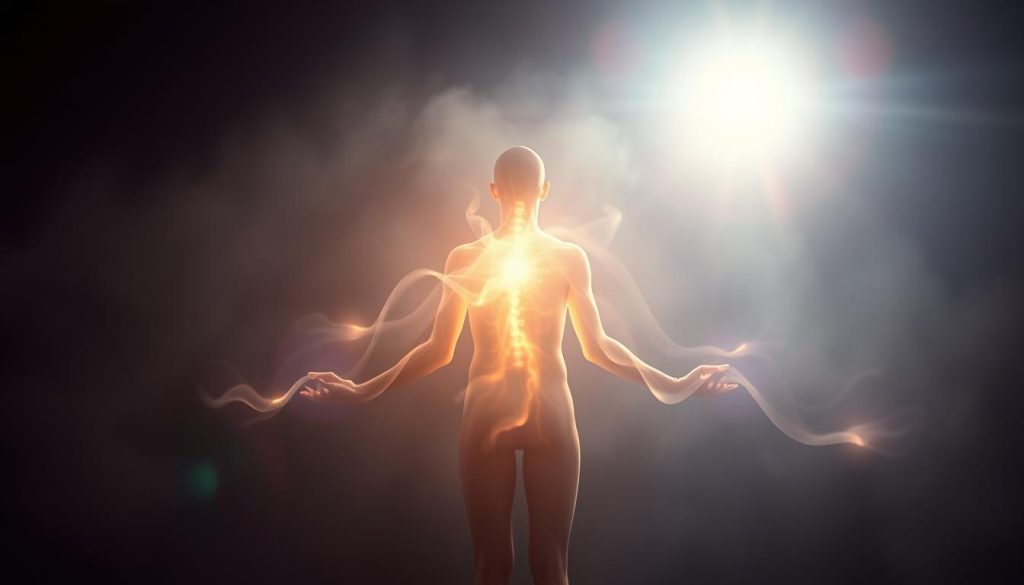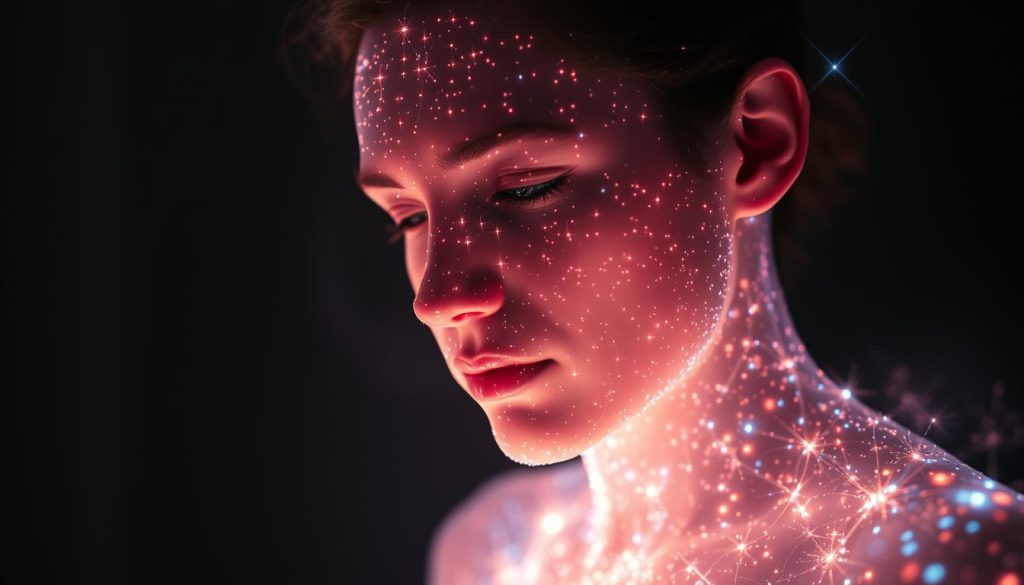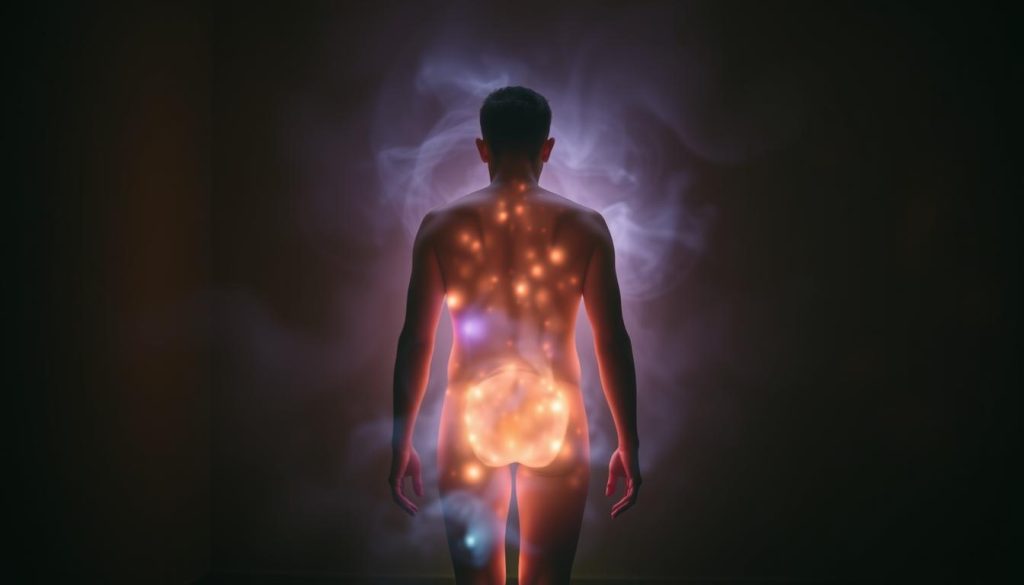Welcome. We open this guide with a simple question about aura as a visible idea and a felt presence. Let’s ask what that glow or color means in daily life.
Next, we name a few ways people describe this sense. Some call it energy or a surrounding field. Others notice shifts in mood or atmosphere and wonder if those feelings map to something real.
Reports list vivid colors, subtle vibrations, and moving light as common phenomena. At the same time, rigorous tests look for repeatable evidence and often find natural explanations.
We’ll trace one core concept and compare old stories with lab work about human energy. This piece is our friendly route from myth to measurement — playful but clear.
Ready to explore? Join us and see which ideas stay and which fall away on the way.
Defining Auras: Origins, Meanings, and How the Concept Evolved
From wind to light: a word’s journey helps us trace how aura took shape in modern thought.
Originally, aura meant a soft breeze in Latin and Greek. By the late 1800s spiritualists borrowed that old term to name a subtle glow around the human body.
Key figures shaped what followed. Charles W. Leadbeater linked chakras to glands and organs. Christopher Hills later painted chakras as rainbow-colored centers. Those moves helped turn complex esoteric maps into simple visual guides.
Over time, varied systems tied color to mood, traits, illness, and spiritual progress. Many people adopted these ideas into holistic medicine and everyday practice.
Still, these claims rest in personal and cultural knowledge rather than lab-proven results. We honor how such maps connect inner life and outer signs while staying clear about what evidence supports.
What People Mean by a “Human Energy Field” Today
When people talk about an energy field today, they often mean the subtle vibe you sense near someone. We use that phrase to point at a felt atmosphere more than a measured signal.
Many frameworks describe human energy as layered. One layer maps to the body, another to thoughts and emotions, and others to spirit. Some call this a system where living organisms radiate low-level electromagnetic activity.
People describe auras and aura colors as part of health maps. These ideas link mood, body, and social awareness. You might notice warmth by someone’s hands, a shift in mood, or calm during shared silence.
While these impressions are real to many, labs have not proven a consistent, measurable aura around every person. A 2018 paper suggested some invisible parts may elude current tools, so study continues.
We invite gentle curiosity: treat your impressions as useful data for your awareness. Explore ways that help you feel grounded, and keep what supports your well‑being.

Seeing Is Believing? Photography and Visualizations of Auras
A camera became a test tube for aura ideas, capturing halos that begged for explanation.
Early experiments include Hippolyte Baraduc’s 1890s images and, later, Semyon Kirlian’s 1939 method. Kirlian photography placed a fingertip or leaf on photographic paper and applied high voltage. A glowing contour appeared from gas ionization, especially when moisture was present.

Science later showed those bright rings change with moisture and contact. The 1976 paper noted image modulation by humidity. Thelma Moss and others offered bioenergies ideas, yet controlled tests found no hidden force.
Modern practitioners use biofeedback cameras and infrared to map color and heat around a body. Such techniques create lovely, pattern-rich images. But reproducibility is weak, and many examples trace to electrical discharge, moisture, or warmth — not a distinct energy field.
We can enjoy these photos as creative mirrors. They spark wonder and invite study. At the same time, current evidence stops short of proving a unique aura captured on film.
The Science Behind Auras: Do Human Energy Fields Really Exist?
Controlled trials give us a clearer lens on claims of seeing colors or sensing a glow.
What does current evidence show? Multiple controlled tests found that claimed abilities to spot someone in darkness or identify a person behind a partition did not beat chance. That weakens confidence in aura phenomena as a repeatable effect.
Kirlian images once fueled wonder. Researchers now explain those patterns by moisture, contact, and ionization. No hidden process turned up.
Reviews by psychologists like Andrew Neher and clinicians such as Steven Novella conclude that psychic explanations lack strong support. Studies on synesthesia links remain speculative and show little behavioral backing.
We also note a clear distinction: living tissues produce measurable electromagnetic signals. That known energy from heart and brain is different from the esoteric aura concept used in some alternative medicine systems.

We can hold curiosity and caution together. Practitioners value these ideas for meaning and care. Yet science asks for mechanisms, reproducible measurements, and clear diagnostics. For now, evidence for existence stays limited while personal experience keeps its place.
What Could People Be Perceiving? Scientific Explanations and Skepticism
Many reported glows may come from normal visual quirks rather than hidden forces.
Our eye and brain are set up to spot edges and contrast. Afterimages, peripheral blur, and contrast effects can create faint halos that feel meaningful.
For example, bright lighting or heat shimmer near bodies can look like a soft glow. Peripheral vision often smooths details and fills gaps with color.
Psychology adds another layer. Fantasy‑proneness and expectation shape awareness. If we expect a glow, subtle cues become convincing evidence.
Some proposed a synesthesia link, but studies (2012 Consciousness and Cognition) found key differences from classic synesthetic patterns.
Experiments also show ability claims struggle under controls — people fail to identify another person behind a partition more often than not.

We can still honor these reports while staying curious. Bodies emit heat and tiny electromagnetic signals, and perception can weave those cues into felt stories.
Friendly skepticism asks for clear mechanisms and repeatable tests. That helps separate likely causes from what remains unexplained, so our shared inquiry stays honest and kind.
How People Attempt to See, Sense, and “Cleanse” Auras
Some seekers train a relaxed stare to catch subtle light that seems to hover near a person. Soft gaze, mirror work, and using peripheral vision are common techniques to try and see aura outlines. We suggest short sessions and gentle rest for the eye.
To sense subtle shifts, people use breathwork, meditation, and attention on chakra centers. These ways help tune awareness and may change mood or calm the body. Try a few minutes of focused breath and notice what shifts.
Simple cleansing routines include positive affirmations, visualization, and smudging with sage. Many find these rituals support healing and clearer thinking. Remember, these acts are meaningful practices rather than proven medical tools.
Some tools map biofeedback to colors and create a snapshot. Treat such results as playful feedback, not definitive proof of a force. Journal what you notice across days. Bring a friend to compare impressions in a kind, low‑pressure way.
Case Studies and Culture: From Practitioners to Pop Media
Stories and studios turn light ideas into shared rituals and conversation. We tour how novels, retreats, and boutique booths shape what people feel and say about a glow around a person.
Fiction gives a vivid example. Lobsang Rampa’s The Third Eye and Stephen King’s Insomnia craft scenes where sight changes after odd acts or new perception. These moments make ideas easy to imagine.
Practitioners offer readings and varied interpretations. Studio photography colorizes portraits, too, and those images spark lively talk about mood and presence.
Public tests that used partitions and mannequins put some claims to the test. Results often landed at chance level, reminding us that anecdotes and controlled trials can tell different stories.
We value how this culture creates connection and curiosity. Enjoy creative work and respectful sharing. At once, keep gentle discernment: art and ritual matter, while validated proof still lags behind many claims about unseen phenomena and aura energy.
Comparing Esoteric Systems: Chakras, Traditional Chinese Views, and the Human Body
Let’s place chakra charts next to meridian maps and notice where they agree and diverge.
Chakras were once tied to glands and organs by Leadbeater and later painted as rainbow centers by Hills. New Age work then matched each center to traits and life stages. Each center keeps a set of colors and meanings that help people read mood and purpose.
Meanwhile, traditional chinese maps speak of qi flowing through meridians. That model uses different terms and diagnostics, yet it also frames balance, flow, and vital force as core to care and wellbeing.
Both systems aim to link parts into a whole. One shows radiant layers, the other traces networked lines across the human body. Practitioners call these an aura or an underlying field of motion.
Scientific proof for these subtle maps is limited. Still, they guide practices—breathwork, acupressure, meditation—that many find grounding. Try them with curiosity. Use what helps your comfort, and keep gentle standards for what counts as clinical medicine.
Where the Evidence Stands Now—and What to Watch Next
We now pause to weigh what controlled tests and careful paper work actually show.
Summary: Repeated trials did not confirm reliable aura detection. Kirlian photography and many photography patterns trace to moisture and ionization, not an unseen field.
Some paper discussions place energy concepts inside traditional systems. Still, robust, reproducible evidence remains scarce. At the same time, people report real benefits from meditation and energy healing; those outcomes speak to healing and state changes, not definitive proof of auras.
What to watch next? Better sensors, blinded designs, and shared data. Invite practitioners and scientists to co-design studies. Track sleep, mood, focus, and personal patterns to build useful awareness.
Keep curiosity bright. Choose practices that help your person, and let wonder meet method.
